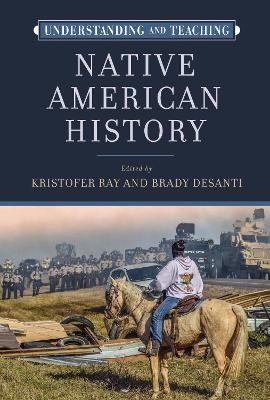
Understanding and Teaching Native American History
University of Wisconsin Press (Verlag)
978-0-299-33854-1 (ISBN)
Understanding and Teaching Native American History is a timely and urgently needed remedy to a long-standing gap in history instruction. While the past three decades have seen burgeoning scholarship in Indigenous studies, comparatively little of that has trickled into classrooms. This volume is designed to help teachers effectively integrate Indigenous history and culture into their lessons, providing richly researched content and resources across the chronological and geographical landscape of what is now known as North America.
Despite the availability of new scholarship, many teachers struggle with contextualizing Indigenous history and experience. Native peoples frequently find themselves relegated to historical descriptions, merely a foil to the European settlers who are the protagonists in the dominant North American narrative. This book offers a way forward, an alternative framing of the story that highlights the ongoing integral role of Native peoples via broad coverage in a variety of topics including the historical, political, and cultural.
With its scope and clarity of vision, suggestions for navigating sensitive topics, and a multitude of innovative approaches authored by contributors from multidisciplinary backgrounds, Understanding and Teaching Native American History will also find use in methods and other graduate courses. Nearly a decade in the conception and making, this is a groundbreaking source for both beginning and veteran instructors.
Kristofer Ray is an Honorary Fellow at the Wilberforce Institute for the Study of Slavery and Emancipation, University of Hull. His areas of expertise include early modern American Indian experience broadly, Native-European interaction in trans-Appalachia specifically, and the European construction of Indigenous slave law. In addition to several book chapters, edited volumes, and journal articles, he is the author of Middle Tennessee, 1775–1825 and the forthcoming Cherokees, Europeans, and Empire in the Trans-Appalachian West, 1670–1774. Brady DeSanti (Lac Courte Oreilles Ojibwe) is the director of Native American studies and an associate professor of religious studies at the University of Nebraska at Omaha. His research focuses on Native American history and religious traditions.
Introduction
Part One: Reflections on Teaching Native American History
Chapter One: Learning to Teach Indian History: A Memoir
By Theda Perdue
Chapter Two: Teaching American Indian History Using the Medicine Way
By Donald Fixico
Chapter Three: Transnational History and Deep Time: Reflections on Teaching Indigenous History from Australia
By Ann McGrath
Chapter Four: Being There: Experiential Learning by Living Native American History
By Bernard Perley
Chapter Five: čwÈ·ˀn neyękwaˀnawèrih: Reflections on Teaching Indigenous History from a Native Student
By Taylor Hummel
Part Two: Reflections on Invasions, Epidemics, War and Genocide
Chapter Six: Before Columbus: Native American History, Archeology, and Resources
By Maureen Meyers
Chapter Seven: Teaching and Understanding Genocide in Native America
By Gray Whaley
Chapter Eight: The “Virgin” Soil Thesis Cover-Up: Teaching Indigenous Demographic Collapse
By Tai S. Edwards
Chapter Nine: Teaching Indian Wars
By Mark van de Logt
Part Three: Essential Topics in Native American History
Chapter Ten: Teaching Indian Slavery: From First Slaves to Early Abolitionists in Four Myths
By Denise I. Bossy
Chapter Eleven: Teaching the American Revolution from Indian Country
By Charles W. Prior
Chapter Twelve: Teaching the Broad and Relevant History of American Indian Removal
By John Bowes
Chapter Thirteen: Teaching and Understanding the History of Allotment
By Rose Stremlau
Chapter Fourteen: Teaching Federal Indian Law through Literature
By N. Bruce Duthu
Chapter Fifteen: Nation-to-Nation: Understanding Treaties and Sovereignty
By Margaret Huettl
Chapter Sixteen: Teaching Indigenous Environmental History
By Paul Kelton and James Rice
Part Four: Reflections on Identity and Cultural Appropriation
Chapter Seventeen: An Appropriate Past: Seminole Indians, Osceola, and Florida State University
By Andrew K. Frank
Chapter Eighteen: Looking Past the Racial Classification System: Teaching Southeastern Native Survival Using the Peoplehood Model
By Marvin Richardson
Chapter Nineteen: Teaching Native American Religions and Philosophies in the Classroom
By Brady DeSanti
Chapter Twenty: Sustenance as Culture and Tradition: Teaching About Indigenous Foodways
By Devon A. Mihesuah
Chapter Twenty-One: Native American Art 101
By Nancy Marie Mithlo
| Erscheinungsdatum | 24.10.2023 |
|---|---|
| Reihe/Serie | The Harvey Goldberg Series for Understanding and Teaching History |
| Zusatzinfo | 4 b&w illus. |
| Verlagsort | Wisconsin |
| Sprache | englisch |
| Maße | 152 x 229 mm |
| Gewicht | 272 g |
| Themenwelt | Geisteswissenschaften ► Geschichte ► Geschichtstheorie / Historik |
| Geisteswissenschaften ► Geschichte ► Regional- / Ländergeschichte | |
| Geschichte ► Teilgebiete der Geschichte ► Kulturgeschichte | |
| Sozialwissenschaften ► Ethnologie | |
| Sozialwissenschaften ► Pädagogik | |
| Sozialwissenschaften ► Soziologie | |
| ISBN-10 | 0-299-33854-1 / 0299338541 |
| ISBN-13 | 978-0-299-33854-1 / 9780299338541 |
| Zustand | Neuware |
| Haben Sie eine Frage zum Produkt? |
aus dem Bereich


